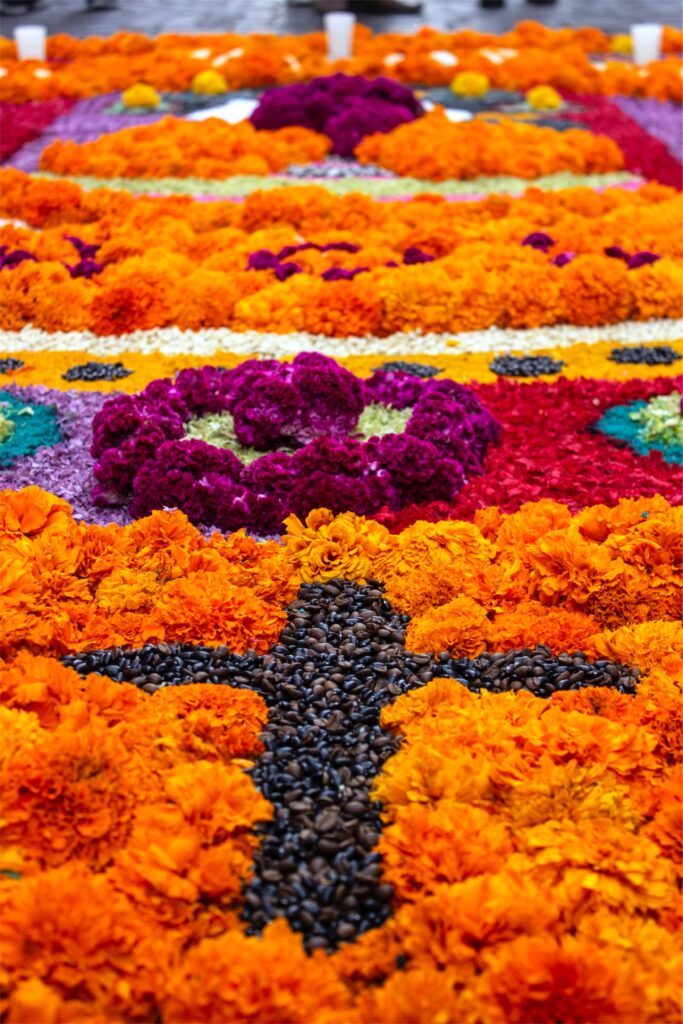
The Day of The Dead
The “Day of the Dead” in Mexico is a revered national remembrance day. This celebration occurs every year on November 2nd, but technically the commencement date is October 31st through November 2nd (Bañuelos, 2020). It is a day in Mexico when people remember their departed relatives, friends, neighbors, and other loved ones. Mexicans consider this celebration a way of integrating death into society (ContentEngineLLC, 2020). A significant Day of the Dead icon is La Calavera Garbancera, also known as “La Catrina.” This image is associated with the celebration and adopted by people who dress as Calavera Garbancera during the celebration. In celebration of the Day of the Dead, participants transform their faces to depict the pasty white color of a dead skeleton with colorful, vibrant, and extravagant flowers depicting the Mexican culture’s love for flowers. People’s faces turn into celebrations of this festivity of the dead, and their decorative features shimmer with the moonlight. It is believed that her origins are rooted in Mesoamerican culture; others say they are an unbreakable bond between the living and the dead. Despite their festive royal hearts, some people are unaware of the history of La Calavera Garbancera.

The Conquest Racial Mixture
A combination of indigenous, African, and Spanish cultures dominates Mexico (Wade 2014). The roots of these early civilizations predate the conquests of the Spanish. The Spanish Crown and Catholic Church deconstructed many traditions and cultural beliefs from these civilizations due to their conquests (Brandes 1997:270-299). One of the seeds which took root after The Spanish influence in Mexico is the Calavera Garbancera, “La Catrina.”
Catrina
La Calavera Garbancera is a satirical depiction of the conquered civilization or people who lost connection to their indigenous roots. This Garbancera illustration depicts an empty skeleton with a big hat and floral arrangements, similar to the European style. In 1912, José Guadalupe Posada Aguila (ContentEngineLLC, 2020) created the illustration. His artwork illustrates the decline of culture or the uprooted transformation related to the acceptance of superior European cultural appropriation over indigenous cultural heritage. Eventually, he created an illustration titled “Finish of Cheerful Skulls,” which depicted indigenous women wearing European fashions and elaborate hats to gain social acceptance according to the era’s social standards. Still, Posada artistically highlighted the identity component of drifting away from their indigenous roots (ContentEngineLLC, 2020). As a result, La Calavera Garbancera is a product of the political rebellion of the early 1900s or of political propaganda, not of the indigenous culture. This illustration is a by-product of the Spanish Conquest and the Crown doctrine of planting seeds of conformity and displacing identity, resulting in the devaluation and silencing of indigenous voices (Brandes, 1997).

The celebration of the “Day of the Dead” is a well-known tradition in Latin America, but the story of Calavera Garbancera sheds light on a deeper issue: the loss of identity. This loss was caused by the crown’s efforts to indoctrinate and conform the people, resulting in stolen identities. Understanding this history is crucial to addressing the toxic seed of identity loss in Latin America.
References
Brandes. (1997). Sugar, Colonialism, and Death: On the Origins of Mexico’s Day of the Dead. Comparative Studies in Society and History, 39(2), 270–299. https://doi.org/10.1017/S0010417500020624
Translated ContentEngine LLC. (2020). Origin of the Calavera Garbancera, better known as ‘La Catrina’; Icon of the Day of the Dead and the Jewel of Posada. CE Noticias Financieras.
https://www.science.org/content/article/people-mexico-show-stunning-amount-genetic-diversity
